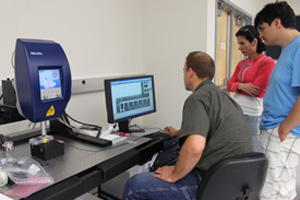New Tool Simplifies MEMS Characterization
July 26, 2010 / By Anna Lynn Spitzer
|
Testing and characterizing these minute devices is challenging. Unlike larger materials and components, which can be examined in a variety of ways, MEMS characterization requires highly specialized tools. The Polytec MSA-500, newly installed in Calit2’s Materials Characterization Lab, is the most advanced of these to date.
The Micro System Analyzer uses light to measure three-dimensional shape and motion in microstructures. It can measure a surface’s topography, much like an atomic force microscope, but faster and easier. In addition, it is capable of measuring and characterizing both in-plane and out-of-plane vibrations, employing a combination of technologies unprecedented in a single instrument.
“Some MEMS vibrometers measure out-of-plane dynamics, while others measure in-plane dynamics, but as far as we know, there is no other commercially available tool that can do both at once,” said Lorenzo Valdevit, mechanical and aerospace engineering, chemical engineering and materials science assistant professor, and the principal investigator on the grant that funded most of the purchase. Engineering professors Andrei Shkel, Abraham Lee, G. P. Li and Derek Dunn-Rankin are co-investigators on the grant.
“This instrument can scan the entire surface of the sample, not just one point at a time,” Valdevit continued. “You can get a ‘movie’ of how your sample is vibrating in real-time, up to very, very high frequencies.”
Seventy percent of the $650,000 purchase price was underwritten by the National Science Foundation’s Major Research Instrumentation R2 program, which utilizes funds from the U.S. Recovery and Reinvestment Act. The remainder was shared by UCI’s Office of Research, The Henry Samueli School of Engineering and Calit2.
The new instrument will facilitate investigations in a wide range of fields, Valdevit said, including MEMS accelerometers, gyroscopes and other vibrating MEMS devices, as well as materials science, medical and biomedical research. One example: A medical school researcher, who is collaborating on the design of micro hearing aids, plans to use the instrument to measure vibrations in tympanic membranes.
Valdevit is interested in optimal design of micro-architected materials. His research involves understanding the extent to which such small-scale structures respond to vibrations. “Many applications require very stiff and strong materials, but they also need to be able to absorb vibrations quickly,” he explained, adding that those characteristics are often mutually exclusive. The new analyzer will go a long way toward developing materials with both attributes. “We will be able to tweak the materials to suit our own purposes,” he said.
The instrument’s long list of benefits, he added, includes ease of use. “The interface is very nice. You just put something under the microscope; it’s very user-friendly.”
And last but not least, “the resolution is quite incredible.”
--Anna Lynn Spitzer


